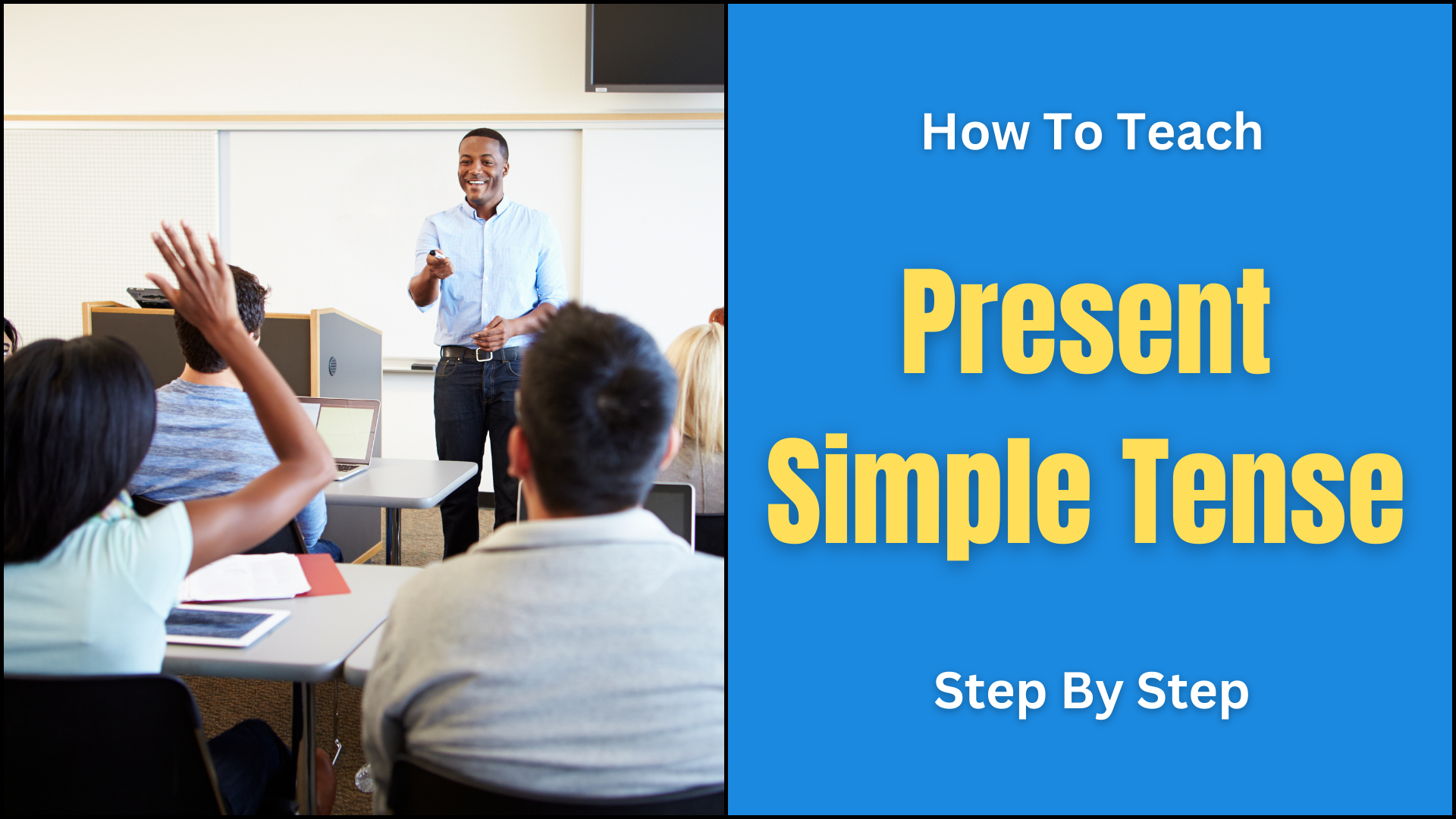How To Teach The Present Simple Tense | Step By Step
The present simple tense can be used in many different ways and so teaching the present simple tense to beginner English language learners can be quite challenging. The main goal when teaching the present simple tense should be to get your students to understand when to use the present simple tense. So, in what situations do we use the present simple tense?
The present simple tense is used to talk about an action which is happening now or something which happens on a regular basis. We use the present simple tense to talk about daily routines and activities, habits, and general truths.
To help you teach the present simple tense we have put together this step by step guide to teaching the present simple tense. In this post you’ll also find links to free resources and exercises to teach the present simple tense.
How To Teach The Present Simple Tense
Step 1: Action Verbs
To begin, elicit some common action verbs from your students. To do this act out some actions and ask your students to guess what it is. For example, you could pick up a book and pretend to read and your students will likely guess the action verb ‘read’. Do the same with other verbs such as write, eat, run, etc, and write them on the board.
Alternatively, if your students are absolute beginners you can use these action verb flashcards to teach them some common verbs.
Once you have written a few verbs on the board in the root form, it’s time to introduce the present simple tense with the first person singular.
Step 2: First Person Singular Form
Next, in front of each verb you have written on the board write ‘I’ and practice saying each of these verbs together with ‘I’. For example, “I read. I write. I eat. I run.”, etc.
Once you have practiced enough elicit from students some actions that they do every day. To do this, you can ask students what the first thing they did that day was. The first thing most, if not all your students did that day was surely ‘wake up’.
Write ‘I wake up’ on the board and then ask students what time they woke up. Then complete the sentence on the board to make the present simple sentence. For example, ‘I wake up at 8.’
Do the same for other daily actions / routines and write these examples on the board. Some example present simple sentences you can elicit are:
- I wake up at 7.
- I eat breakfast at 8.
- I go to school at 8:30.
- I study English at 10.
- I have lunch at 12.
- I go home at 3.
- I do my homework at 5.
- I cook dinner at 7.
- I go to bed at 11.
Once students have practiced enough introduce the second person singular form.
Step 3: Second Person Singular.
Once students have grasped how to form the present simple tense in the first person singular form it is quite easy to then make the present simple tense in the second person singular form.
To demonstrate this form to students ask one student “What time do you get up?” and that student will answer something like “I wake up at 7 o’clock.”.
Then point at that student and say “You wake up at 7 o’clock.” Next, ask the student again “What time do you get up?” then when he/she answers, encourage the rest of the class to point at the student and say “You get up at 7 o’clock.”
After demonstrating the second person singular form of the present simple tense, go around the class and ask different students different questions. Each time they answer encourage the rest of the class to point at the student and make a present simple sentence in the second person singular form.
Step 4: Third Person Singular
Now that students have had plenty of practice making present simple tense sentences it is time to introduce the third person singular form. Explain to students that when talking about someone (singular) in the third person, the verb changes.
To demonstrate this form to students, ask a student again “What time do you get up?” and he/she will answer “I get up at 7 o’clock.”. Then you can say “Sally gets up at 7 o’clock.”
Do the same with a few students to demonstrate these present simple sentences in the third person singular form. Then ask students to identify how the verb changed in those sentences.
Students will likely notice that you added an ‘s’ to the verb ‘get’. Once students understand that when talking in the third person singular that they should ad s / es to the root form of the verb, get students to practice making these sentences themselves.
A great activity to do this is to give students a few minutes to ask their partner some questions about their daily routine. Then after a few minutes, go around the class and ask students to tell you about their partner’s routine. They will make sentences like “He wakes up at 8.” , “She goes to school at 9.”, etc.
Step 5: Plural Forms
Next, teach students the present simple tense with plural forms. Explain to students that when using the plural form, the verb does not change. Then, demonstrate some examples and practice.
A great way to do this is by asking the whole class some simple questions. For example, ask students if they like a certain food (let’s say sushi) and ask them to raise their hand / move to one side of the room if they do. Then point at this group and say “They like sushi.” Ask the rest of the class to do they same. Then, join those students and say “We like sushi.”
Do the same with many other questions so students can practice making present simple sentences with plural forms.
Step 6: Negative Present Simple Sentences
To make negative present simple sentences you simply add do/does+not (don’t / doesn’t) to the root form of the verb.
A fun way to practice this is to give students a few minutes to ask their partner about food / activities that they like or don’t like. Then go around the class and ask students to tell you about what their partner likes or doesn’t like.
For example, a students might say “Chris likes pizza. He doesn’t like sushi.”
Once students have been introduced thoroughly to the different ways to form the present simple tense, it’s time to consolidate everything they’ve learned about the present simple tense.
Step 7: Present Simple Exercises
To review everything students have learned and to check their understanding, ask students to complete some present simple exercises.
Here are some great present simple exercise worksheets you can use to help students focus on the present simple form:
- Present Simple Exercise (Positive)
- Present Simple Exercise (Negative)
- Present Simple With Be Verb (Positive)
- Present Simple With Be Verb (Negative)
And here are some interactive online present simple exercises you can use. These can be used in class, or students can complete these activities independently for homework.
- Present Simple With Be Verb – Positive
- Present Simple With Be Verb – Negative
- Present Simple With All Verbs – Positive
- Present Simple With All Verbs – Negative
It may take your students time to master the present simple tense, and it is probably best to introduce the different forms of the present simple tense over several lessons to give them plenty of time to practice.
Thanks for reading. I hope you found this step by step guide to teaching the present simple tense useful.
Before you go, don’t forget to check out our FREE lesson materials for teaching English, including Activity Videos, ESL Worksheets, Vocabulary Exercises, Grammar Exercises, Board Games, PowerPoint Games, PowerPoint Lessons, and much more.


